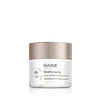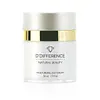What's inside
What's inside
 Key Ingredients
Key Ingredients

 Benefits
Benefits

 Concerns
Concerns

 Ingredients Side-by-side
Ingredients Side-by-side

Water
Skin ConditioningGlycerin
HumectantDimethicone
EmollientHydrogenated Ethylhexyl Olivate
EmollientCoco-Caprylate
EmollientCetearyl Alcohol
EmollientOctyldodecyl Oleate
EmollientCetyl Alcohol
EmollientCaprylic/Capric Triglyceride
MaskingGlyceryl Stearate
EmollientInulin
Skin ConditioningOctyldodecyl Stearoyl Stearate
EmollientTocopheryl Acetate
AntioxidantCentella Asiatica Extract
CleansingSodium Hyaluronate
HumectantCarnosine
Skin ConditioningAlpha-Glucan Oligosaccharide
CleansingHydrolyzed Collagen
EmollientHydrolyzed Elastin
EmollientGlycine Soja Oil
EmollientHydrogenated Olive Oil Unsaponifiables
EmollientTocopherol
AntioxidantGossypium Herbaceum Seed Oil
Skin ConditioningPersea Gratissima Oil
Skin ConditioningPrunus Amygdalus Dulcis Oil
Skin ConditioningHelianthus Annuus Seed Oil
EmollientMangifera Indica Seed Butter
Skin ConditioningOlea Europaea Fruit Oil
MaskingTheobroma Cacao Seed Butter
EmollientGlutathione
Ascorbic Acid
AntioxidantPEG-75 Stearate
Propylene Glycol
HumectantAmmonium Acryloyldimethyltaurate/Vp Copolymer
Disodium Cetearyl Sulfosuccinate
CleansingHydroxyacetophenone
AntioxidantPyruvic Acid
MaskingCeteth-20
Cleansing1,2-Hexanediol
Skin ConditioningLactic Acid
BufferingCaprylyl Glycol
EmollientXanthan Gum
EmulsifyingEthylhexylglycerin
Skin ConditioningPolyhydroxystearic Acid
EmulsifyingOctyldodecanol
EmollientPhytic Acid
Sorbitol
HumectantMica
Cosmetic ColorantPropanediol
SolventCI 77491
Cosmetic ColorantColloidal Gold
AntimicrobialParfum
MaskingSodium Hydroxide
BufferingCI 77891
Cosmetic ColorantPotassium Sorbate
PreservativeSodium Benzoate
MaskingT-Butyl Alcohol
PerfumingWater, Glycerin, Dimethicone, Hydrogenated Ethylhexyl Olivate, Coco-Caprylate, Cetearyl Alcohol, Octyldodecyl Oleate, Cetyl Alcohol, Caprylic/Capric Triglyceride, Glyceryl Stearate, Inulin, Octyldodecyl Stearoyl Stearate, Tocopheryl Acetate, Centella Asiatica Extract, Sodium Hyaluronate, Carnosine, Alpha-Glucan Oligosaccharide, Hydrolyzed Collagen, Hydrolyzed Elastin, Glycine Soja Oil, Hydrogenated Olive Oil Unsaponifiables, Tocopherol, Gossypium Herbaceum Seed Oil, Persea Gratissima Oil, Prunus Amygdalus Dulcis Oil, Helianthus Annuus Seed Oil, Mangifera Indica Seed Butter, Olea Europaea Fruit Oil, Theobroma Cacao Seed Butter, Glutathione, Ascorbic Acid, PEG-75 Stearate, Propylene Glycol, Ammonium Acryloyldimethyltaurate/Vp Copolymer, Disodium Cetearyl Sulfosuccinate, Hydroxyacetophenone, Pyruvic Acid, Ceteth-20, 1,2-Hexanediol, Lactic Acid, Caprylyl Glycol, Xanthan Gum, Ethylhexylglycerin, Polyhydroxystearic Acid, Octyldodecanol, Phytic Acid, Sorbitol, Mica, Propanediol, CI 77491, Colloidal Gold, Parfum, Sodium Hydroxide, CI 77891, Potassium Sorbate, Sodium Benzoate, T-Butyl Alcohol
Water
Skin ConditioningCarthamus Tinctorius Oleosomes
EmollientPrunus Amygdalus Dulcis Oil
Skin ConditioningHelianthus Annuus Seed Oil
EmollientSimmondsia Chinensis Seed Oil
EmollientVitis Vinifera Seed Oil
EmollientSodium Acrylate/Sodium Acryloyldimethyl Taurate Copolymer
Emulsion StabilisingSqualane
EmollientXylitylglucoside
HumectantNiacinamide
SmoothingOlive Oil Glycereth-8 Esters
EmollientAnhydroxylitol
HumectantAloe Barbadensis Leaf Juice
Skin ConditioningXylitol
HumectantSr-Spider Polypeptide-1
Skin ProtectingTocopherol
AntioxidantAscorbyl Palmitate
AntioxidantRetinyl Palmitate
Skin ConditioningCitrus Aurantium Bergamia Fruit Oil
MaskingGlycereth-2 Cocoate
EmulsifyingPhenoxyethanol
PreservativeDecylene Glycol
Skin ConditioningCaprylyl Glycol
EmollientSodium Benzoate
MaskingPotassium Sorbate
PreservativeParfum
MaskingWater, Carthamus Tinctorius Oleosomes, Prunus Amygdalus Dulcis Oil, Helianthus Annuus Seed Oil, Simmondsia Chinensis Seed Oil, Vitis Vinifera Seed Oil, Sodium Acrylate/Sodium Acryloyldimethyl Taurate Copolymer, Squalane, Xylitylglucoside, Niacinamide, Olive Oil Glycereth-8 Esters, Anhydroxylitol, Aloe Barbadensis Leaf Juice, Xylitol, Sr-Spider Polypeptide-1, Tocopherol, Ascorbyl Palmitate, Retinyl Palmitate, Citrus Aurantium Bergamia Fruit Oil, Glycereth-2 Cocoate, Phenoxyethanol, Decylene Glycol, Caprylyl Glycol, Sodium Benzoate, Potassium Sorbate, Parfum
Alternatives
Ingredients Explained
These ingredients are found in both products.
Ingredients higher up in an ingredient list are typically present in a larger amount.
Caprylyl Glycol is a humectant and emollient, meaning it attracts and preserves moisture.
It is a common ingredient in many products, especially those designed to hydrate skin. The primary benefits are retaining moisture, skin softening, and promoting a healthy skin barrier.
Though Caprylyl Glycol is an alcohol derived from fatty acids, it is not the kind that can dry out skin.
This ingredient is also used as a preservative to extend the life of products. It has slight antimicrobial properties.
Learn more about Caprylyl GlycolHelianthus Annuus Seed Oil is the oil derived from the seeds of a Sunflower. Sunflower seed oil is non-fragrant. It is an emollient, meaning it helps to soften the skin.
Sunflower seed oil contains many fatty acids. The fatty acids found in sunflower seeds include (from highest amount to least): linoleic acid, myristic acid, palmitic acid, stearic acid, arachidic acid, oleic acid, and linolenic acid.
These fatty acids help the skin create ceramides. Ceramides play a role in repairing the skin barrier.
Helianthus Annuus Seed Oil helps moisturize the skin. This in turn helps the skin look more rejuvenated and smoother.
Sunflowers are rich in vitamin E.
Historians believe Indigenous cultures of North America domesticated sunflowers before corn. Thus they relied on sunflower oil for a variety of uses. One such use is moisturizing skin and hair.
Sunflower seed oil may not be fungal acne safe. We recommend speaking with a professional if you have any concerns.
Learn more about Helianthus Annuus Seed OilParfum is a catch-all term for an ingredient or more that is used to give a scent to products.
Also called "fragrance", this ingredient can be a blend of hundreds of chemicals or plant oils. This means every product with "fragrance" or "parfum" in the ingredients list is a different mixture.
For instance, Habanolide is a proprietary trade name for a specific aroma chemical. When used as a fragrance ingredient in cosmetics, most aroma chemicals fall under the broad labeling category of “FRAGRANCE” or “PARFUM” according to EU and US regulations.
The term 'parfum' or 'fragrance' is not regulated in many countries. In many cases, it is up to the brand to define this term.
For instance, many brands choose to label themselves as "fragrance-free" because they are not using synthetic fragrances. However, their products may still contain ingredients such as essential oils that are considered a fragrance by INCI standards.
One example is Calendula flower extract. Calendula is an essential oil that still imparts a scent or 'fragrance'.
Depending on the blend, the ingredients in the mixture can cause allergies and sensitivities on the skin. Some ingredients that are known EU allergens include linalool and citronellol.
Parfum can also be used to mask or cover an unpleasant scent.
The bottom line is: not all fragrances/parfum/ingredients are created equally. If you are worried about fragrances, we recommend taking a closer look at an ingredient. And of course, we always recommend speaking with a professional.
Learn more about ParfumPotassium Sorbate is a preservative used to prevent yeast and mold in products. It is commonly found in both cosmetic and food products.
This ingredient comes from potassium salt derived from sorbic acid. Sorbic acid is a natural antibiotic and effective against fungus.
Both potassium sorbate and sorbic acid can be found in baked goods, cheeses, dried meats, dried fruit, ice cream, pickles, wine, yogurt, and more.
You'll often find this ingredient used with other preservatives.
Learn more about Potassium SorbatePrunus Amygdalus Dulcis Oil comes from the sweet almond, a tree native to Iran. This oil has no fragrance and is non-volatile.
Almonds contain healthy fats, vitamins, and minerals. It is a rich source of Vitamin E, a great antioxidant and skin conditioning ingredient. Sweet almond oil contains fatty acids such as linolenic acid and triglycerides.
The content of sweet almond oil makes it a great emollient; it can help soften and hydrate your skin. Emollients create a barrier over your skin to trap moisture in. Sweet almond oil has antioxidant properties.
Those with an almond allergy should be careful of this ingredient and speak with a professional about using it in your skincare.
This ingredient may not be fungal-acne safe.
Learn more about Prunus Amygdalus Dulcis OilSodium Benzoate is a preservative. It's used in both cosmetic and food products to inhibit the growth of mold and bacteria. It is typically produced synthetically.
Both the US FDA and EU Health Committee have approved the use of sodium benzoate. In the US, levels of 0.1% (of the total product) are allowed.
Sodium benzoate works as a preservative by inhibiting the growth of bacteria inside of cells. It prevents the cell from fermenting a type of sugar using an enzyme called phosphofructokinase.
It is the salt of benzoic acid. Foods containing sodium benzoate include soda, salad dressings, condiments, fruit juices, wines, and snack foods.
Studies for using ascorbic acid and sodium benzoate in cosmetics are lacking, especially in skincare routines with multiple steps.
We always recommend speaking with a professional, such as a dermatologist, if you have any concerns.
Learn more about Sodium BenzoateTocopherol (also known as Vitamin E) is a common antioxidant used to help protect the skin from free-radicals and strengthen the skin barrier. It's also fat soluble - this means our skin is great at absorbing it.
Vitamin E also helps keep your natural skin lipids healthy. Your lipid skin barrier naturally consists of lipids, ceramides, and fatty acids. Vitamin E offers extra protection for your skin’s lipid barrier, keeping your skin healthy and nourished.
Another benefit is a bit of UV protection. Vitamin E helps reduce the damage caused by UVB rays. (It should not replace your sunscreen). Combining it with Vitamin C can decrease sunburned cells and hyperpigmentation after UV exposure.
You might have noticed Vitamin E + C often paired together. This is because it is great at stabilizing Vitamin C. Using the two together helps increase the effectiveness of both ingredients.
There are often claims that Vitamin E can reduce/prevent scarring, but these claims haven't been confirmed by scientific research.
Learn more about TocopherolWater. It's the most common cosmetic ingredient of all. You'll usually see it at the top of ingredient lists, meaning that it makes up the largest part of the product.
So why is it so popular? Water most often acts as a solvent - this means that it helps dissolve other ingredients into the formulation.
You'll also recognize water as that liquid we all need to stay alive. If you see this, drink a glass of water. Stay hydrated!
Learn more about Water